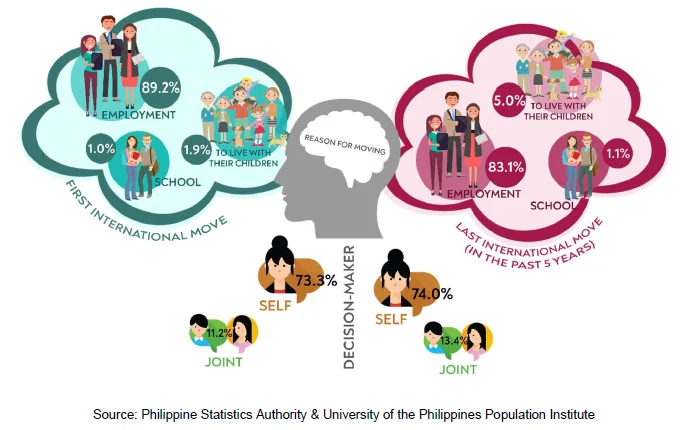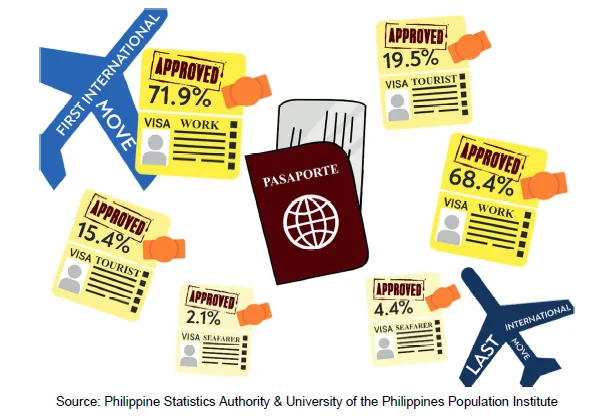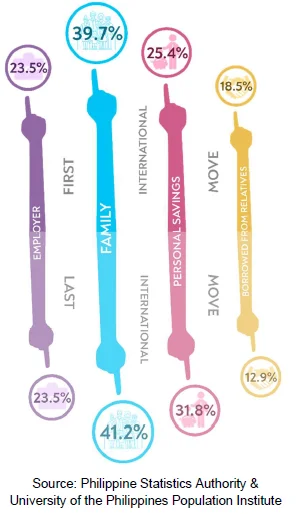Release Date :
The 2018 National Migration Survey (NMS 2018) is the first nationwide survey on migration in the Philippines. It aims to provide information on the mobility of the Philippine population in order to assist policymakers and program managers in designing and evaluating strategies for improving services for, and assistance provided to, Filipinos going abroad or moving within the country. It was jointly implemented by the Philippine
Statistics Authority (PSA) and the University of the Philippines Population Institute (UPPI). This Special Release explores the situations and motives of Filipinos before their first international move, as well as prior to their last international move in the past five years – their reasons for moving, persons who decided to move, modes of financing the move, the type of visa used for the move, their household’s economic situation before the move, and internal migration.
Employment is the main driver of international migration
- The NMS 2018 data show that only 6.4% of Filipinos aged 15 years and over have experienced living in another country for at least three months, with females (7.1%) being relatively more migratory than males (5.7%). Moreover, nearly 2 in 10 Filipinos have a recent international migration experience, that is living or residing in another country for at least three months in the past five years.
Figure 1. Percent Distribution of International Migrants Aged 15 and Over by
Main Reason and Decision-Maker for the First-Ever International Move and
Last International Move in the Past Five Years, Philippines: 2018

- More Filipinos in the older age groups (30-39 years and older) had an international migration experience compared to those in the younger age brackets. However, in terms of international migration in the last five years, a higher proportion of Filipinos in the younger age groups (20-29 years old at 60.3%) were involved in international migration than those in the older age groups.
-
In terms of educational attainment, the percentage of Filipinos with international migration experience increases as education level increases. For the first-ever international move, the percentage increases from 2.7% of those with less than high school education to 10.8% of those college education or higher. On the other hand, for international migration for the past five years, the percentage ranges from 17.8% of those with less than high school education to 18.8% of those with college education or higher.
-
Among all the regions, the percentage of Filipinos with an international migration experience was highest in ARMM (11.5%) followed by Cagayan Valley (11.2%) and Ilocos Region (10.8%). Meanwhile, it was lowest in CARAGA (2.7%). The percentage ranged from 11.6% in ARMM to 33.0% in Northern Mindanao for the most recent international migration experience in the past five years.
-
Nine in ten migrants cited employment as their main reason for their first-ever international move. This was also the reason given by the majority of the migrants for their last international move in the past five years. This is true for both sexes but more so among males.
-
A minimal percentage of migrants mentioned that their reason for their first-ever international move was to live with their children (1.9%) and to attend school (1.0%). Meanwhile, 5.0% of migrants said that the main reason for their most recent international move in the past five years was to live with their children and 1.1% of them, to attend school.
-
Nearly three in four Filipinos decided their first-ever (73.3%) and most recent (74.0%) international migration experiences by themselves. On the other hand, decisions on their first ever international move were made jointly by 11.2% of the migrants and their spouse; 13.4% made joint decisions for their most recent international move in the past five years.
Family is the top provider of financial support for international moves
- The 2018 NMS results show that the financial support from the family was the top source of funding for the first-ever international migration of Filipinos.
Figure 2. Percent Distribution of Internal Migrants Aged 15 and Over by Type
of Visa Used in the First-Ever International Move and in the Last International
Move in the Past Five Years, Philippines: 2018

- One of four Filipino migrants (25.4%) claimed that their first-ever international move was funded by either their salaries, personal funds, or savings. Meanwhile, employers funded nearly a quarter (23.5%) of the firstever international migration of Filipinos in 2018.
-
Filipinos with no personal savings or financial support from their families resorted to borrowing from friends and relatives (18.5%). Three percent of migrants sold or pawned their assets in order to fund their international transfer while some (2.5%) acquired formal and informal loans.
-
The family was also the main source of funding for their most recent international migration experience in the past five years (41.2%). This was followed by salary, personal funds, and savings (31.8%), employer (23.5%), and finances borrowed from friends and relatives (12.9%).
Over, by Financing of the First International Move and Last International Move in the
Past Five Years, Philippines: 2018

Filipinos belonging to households with insufficient finances were likely to migrate
- A great majority of the Filipino migrants (71.9%) lived or resided in another country for three months or more with a valid visa or permit. Fifteen percent of Filipino migrants were with a tourist visa during their first international move. A few Filipinos did not need a visa during their first international transfer.
-
Four in ten Filipino migrants considered themselves as part of households that do not have enough finances to cover their basic necessities prior to their first-ever international move. Slightly more females (45.9%) than males (42.4%) provided this evaluation of their respective households.
-
In terms of last international move in the last five years, majority of Filipino migrants (61.0%) said their households did not have difficulties in meeting their basic needs. However, more than a third (36.3%) reported that their household had difficulty in providing their basic needs, prior to the move. Females (41.9%) shared this assessment more than males (29.2%).
Internal migration highly influenced by employment
- The 2018 NMS results reveal that more than a tenth or 13% of Filipinos moves to their current residence within the past five years prior to the survey.
-
As with international migration, the most cited reason for the first-ever internal move of respondents was employment. About half of internal migrants raised work and other work-related concerns as their purpose of their first-ever move; 23% for the last internal move in the past five years.
-
The first-ever internal migration experience was a personal decision of Filipinos. Four in ten Filipinos said that they were the ones who made the decision to move to another part of the country. Only 12% of the respondents claimed that the transfer was a joint decision between them and their spouses.
-
The funds used to move to the current residence in the past five years was funded by personal savings (54.5%), followed by financial support from family (40.2%).
-
More than three in ten Filipino migrants reported that they belonged to households who were unable to cover their basic needs prior ro moving to their current residence.

